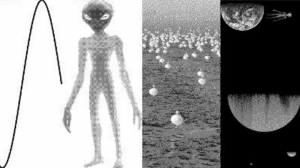In 1961, a small group of scientists met at the Green Bank radio astronomy observatory in West Virginia to discuss the search for extraterrestrial intelligence. One of the organizers was Frank Drake, who used the conference to present his now famous Drake equation describing the likelihood of intelligent life elsewhere in the universe. But Drake also used the occasion to carry out a less-well-known experiment.
The question he addressed was the following. If humanity received a message from the stars, how could we decode it given that it we have no language in common? Similarly, if we want to send a message, how should we compose it?
To explore this issue, Drake created a message of his own and challenged the participants at the conference to decode it. He received a single reply written in the same code, clearly indicating that the message had been understood. Afterward, an amateur electronics magazine published the message, and about a year later, Drake received a letter with the correct solution from a reader of this magazine.
That points to an interesting idea. If we ever receive a message from the stars, one option would be to release it via social media and exploit the world’s combined brain power to decode it.
Last year, one researcher tested this idea by doing exactly that. Rene Heller from the Max Planck Institute for Solar System Research in Germany created a simulated message from an alien civilization and released it on Twitter and Facebook for the world to decode. “On Tuesday, 26 April 2016, I submitted a fake SETI message to the social media Twitter and Facebook and called it the SETI Decrypt Challenge,” say Heller.
Today, he publishes the results of this experiment, showing how people joined forces to crack the seemingly alien code.
The challenge that Heller set is to imagine that Earth has received a message in the form of series of radio pulses from a fixed, unresolved source about 50 light years from Earth. These pulses have been received in a narrow band around an electromagnetic frequency of 452.13 MHz, a frequency that is pi times the emission frequency of neutral hydrogen atoms.
Heller has placed an audio version of the message here. And the question he asks: what does this message say?
Heller constructed the message using some techniques that have already been used in messaging extraterrestrial intelligences. The message consists of a number of pictures that can be constructed by arranging the data in an array of particular dimensions.
These dimensions are 359 by 757 pixels (both prime numbers) and are defined at the beginning of the message by sequences 757 0s and 359 1s. This encodes the first page of the message, which is otherwise blank. In total, the message contains seven pages (another prime number).
The next page is a list of numbers from 0 to 756 which uses a standard system of data encoding called little endian which defines things like the data being written from left to right and so on.
The third page lists the first 757 prime numbers in the same way. “Pages two (simple counting) and three (prime numbers) were meant to establish that we are talking binary and that we use numbers to describe and interpret the images,” says Heller.
The fourth page starts by defining two more numbers. The first is the wavelength used to transmit the message in units of the modified Planck Length. This number is 1.6368 x 1034 and acts as a kind of spatial yardstick.
The second number is 1.1677 x 1052. This is a temporal yardstick that, with some careful thought and simple mathematics, leads to the number 50—the distance of the transmitting civilization in light years. “As we know that the message comes from a star 50 light years away, our alien friends are telling us that they know their distance to us as well,” says Heller.
The rest of page four displays a sine wave, or more precisely the function—sin(x).
The first two lines of page five encode the numbers 6.048 × 1034 and 4.2038 × 1052. These represent the distance 2.45 meters in units of the modified Planck constant and a time of 180 years in units of the temporal yardstick. The rest of this page displays an image of an alien specimen with the clear implication that it is 2.45 meters tall with a life span of 180 years.
The sixth page shows an image of the device used to send the transmission; actually a picture of an Earthbound radio telescope called the Square Kilometer Array.
The final page encodes two numbers equivalent to a distance about 100 times larger than the Earth-moon distance and six billion years. It also displays an image of four astronomical objects, one of which is next to an image of an alien. The implication here is that this depicts ET’s home planet, which is a billion years older than ours.
Heller released this message on social media on April 26, 2016, and it didn’t take long for the world to respond. Heller received the first correct solution by e-mail the following day, and the number of responses increased as news of the challenge spread.
On May 6, Heller received the largest number responses after the Daily Mail and the Huffington Post reported the challenge. At this, a group on Reddit posted the answer, which probably distorted the result Heller got after this. In total he received, 66 correct solutions, two of which were from high school students.
That’s interesting work that has clear implications for the way humanity should deal with a message from the stars. The astronomical community is already committed to publicly releasing any message it receives from extraterrestrials.
But Heller’s work shows that this is not just lip service to the people who pay for astronomy. It shows that the global community is capable of decoding such a message and should be given the chance. “Distribution in the social media would not only offer an efficient means of decryption but also offer an unprecedented opportunity to unite humans all over the globe in a common scientific and cultural effort,” he concludes.
The participants of the first SETI meeting at Green Bank in 1961 would surely agree.
Ask me anything
Explore related questions





